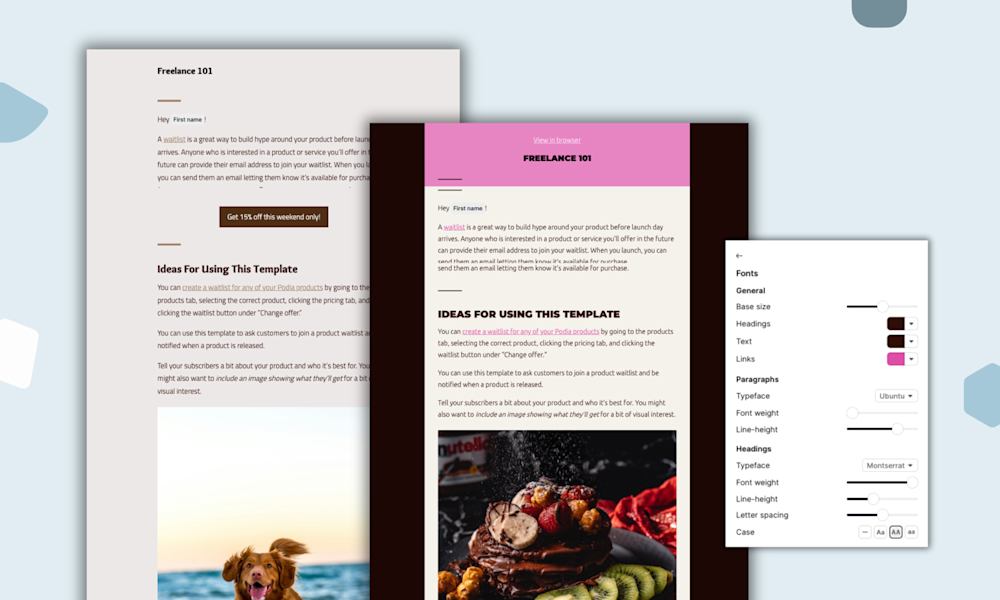Email marketing is like throwing out a joke from stage in a standup routine.
If it resonates, you get roaring laughter.
If not ... crickets.
The same feedback response goes for your email marketing campaigns.
The most effective emails speak to your recipient’s specific situation.
Miss the mark, and the messaging in your email campaign falls flat.
To help you nail your email messaging, we break down five vital types of emails, plus 14 email templates, that you can add to your email sequence right away.
We show you how to write emails that resonate with your audience, so you can use email copywriting as your top salesperson.
Before we dive in, though, let’s cover how to use our email marketing templates the right way.
How to use our email templates
The key to using our email templates is to send personalized emails.
More importantly, make your messaging specifically relevant to your subscribers.
After all, people crave customization and personalization.
Personalized emails deliver transaction rates that are six times higher than non-personalized emails.
The email templates we share with you today cater to the awareness funnel and, more specifically, where your audience sits among these five stages of awareness:
-
Really unaware — They don’t know about their problem.
-
Problem-aware — They know they have a problem, but don’t know how to fix it.
-
Solution-aware — They know there are solutions, but don’t know about yours.
-
Product-aware — They know about your product, but aren’t sure it’s the solution.
-
Most aware — They know about your product and may purchase, but need more info.

Even if you’re sending automated emails, a foundational way to personalize your emails is to use segmentation, which is when you group your email list into subscribers with similarities.
People who opt-in to a specific lead magnet or people who are in your family and friends email list, for example, can be segmented into two groups. You can get super specific and segment your list by behavior, like if someone clicks to a specific landing page.
Once your email list is segmented, it’s about sending the right messaging to the right group.
As an obvious example, it doesn’t make sense to send a welcome email, like this one from Warby Parker, to past purchasers and loyal lifetime customers.

But it does make sense to send a welcome email, or even a cold email, to new subscribers.
On the other side of the coin, loyal customers would probably appreciate a follow-up email with messaging that checks in on their progress or experience, like this Uber email.
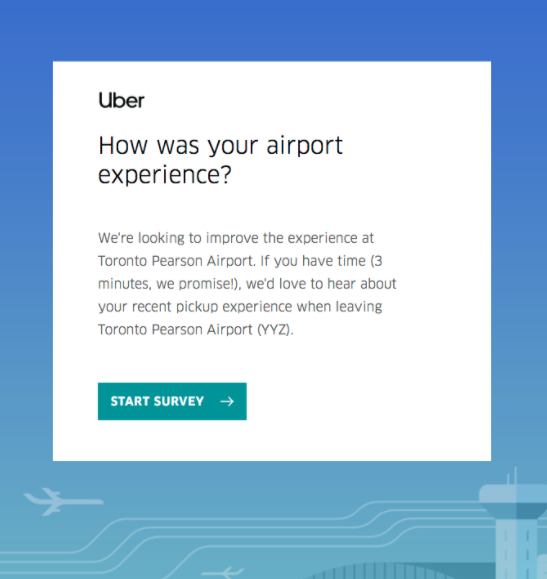
Beyond sending personalized emails, it’s also important to couple our email templates with relevant subject lines.
Above all else, test your subject lines. There’s no surer way to boost your open rates.
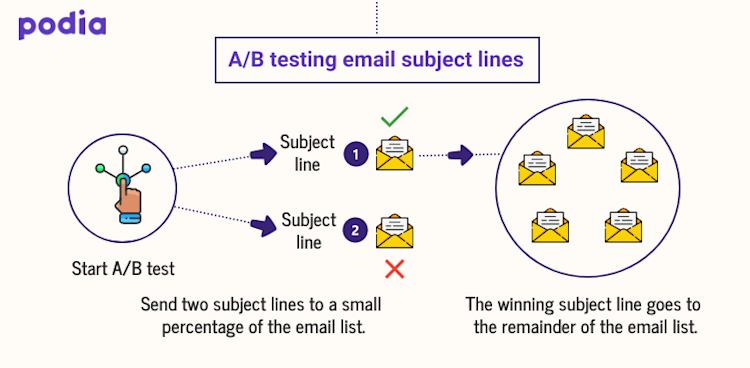
Split testing your subject lines is such an important part of your email strategy that minor changes — from the number of words to the type of words — can lift or squash your open rates.
For instance, a quick swap for the phrase “50% off” with “advance your career” scored 13.3% more opens.
Without optimizing your subject lines — and, ultimately, your open rate metrics — even your best emails won’t be read.
Thirdly, it’s worth adding your own tailored call-to-action (CTA) to the end of your email.
The best response rates happen when you match your email content marketing goal to your subscribers’ awareness level.
Again, that means personalization is key. Personalized CTAs convert 202% better.
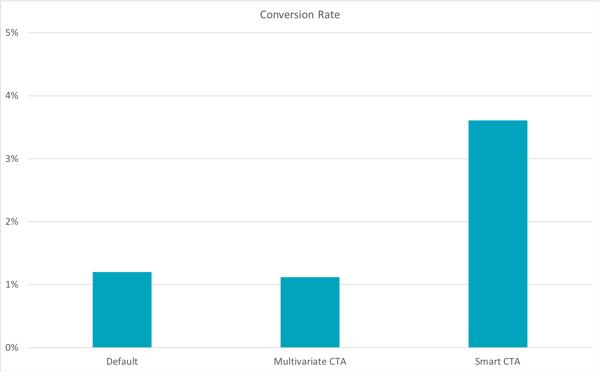
Even without smart CTA software, you can personalize your CTA to match the goal of your email messaging and subscribers’ awareness level.
For instance, here’s a range of problem-aware CTA themes that I’ve used in various digital marketing campaigns throughout my experience as a marketer:
-
Join our social media channel
-
Watch our webinar
-
Listen to our podcast
-
Sign up for our event
-
Purchase our product
-
Submit your answers
-
Schedule a meeting
As you can see, CTA goals vary across the board, so customize it to your email goal and subscribers.
Lastly, a friendly housekeeping reminder:
With any email automation, whether an email newsletter or personalized email, it’s legally required to include an unsubscribe option in your email design.
If you want to keep it separate from your main messaging, a simple hyperlinked “unsubscribe” at the bottom real estate will do, like in this email I received from Peter Voogd.
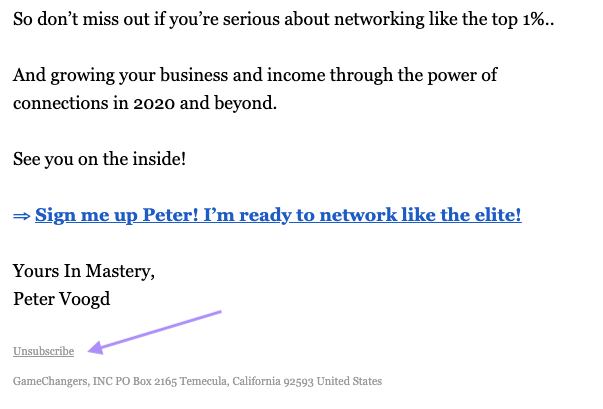
Basically, don’t just copy and paste our email marketing templates.
Instead, turn them into your own email messaging to reflect both your brand’s messaging and recipients’ awareness stage. Also, use segmentation to send personalized emails, include a relevant CTA in your email design, and test your subject lines.
OK. Without further ado, here are 14 email templates to send to your subscribers categorized by the five stages of awareness.
Email templates for completely unaware customers
#1. The introducing brand email template
Beyond your welcome email, after subscribers opt in to your email list, they may not know much about your business other than your brand name.
And in some cases, remembering your brand name might be a stretch for people, especially if you’re just starting out.
For instance, if you use a lead magnet to attract subscribers, maybe they’re only familiar with what they signed up for — say, a digital download — and not much else.
That’s what happens to 43% of consumers — after opting-in to an email list, they don’t recognize the brand or don’t remember signing up for it.
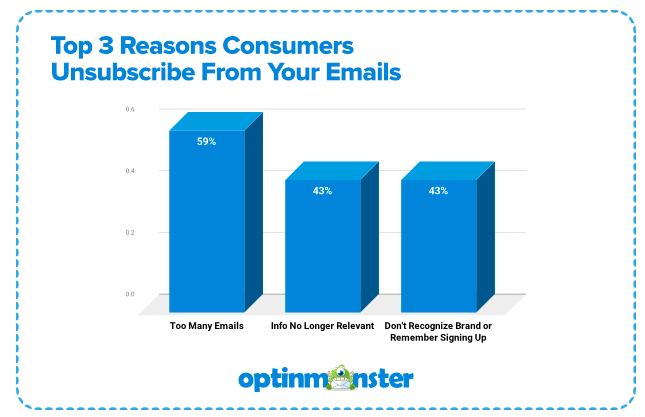
To help curb this top reason why consumers unsubscribe, this first email template helps you add more color to your brand and simply inform them. It’s a way to familiarize your subscribers with your brand and how you help people.
Feel free to add some passion into your copy and hit home with your “why”. The whole reason why your company exists is for the sole purpose of helping people solve their specific problems, right?
You can express your mission in this messaging, too.
Here’s what I mean in template form:
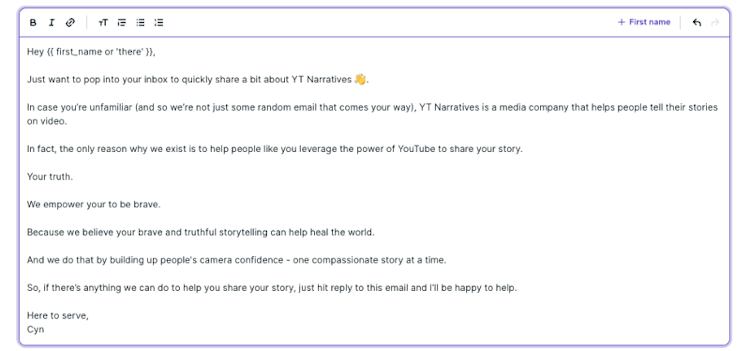
After breaking the ice, you can warm up your audience to the idea of having a problem. Don’t worry, there’s a way to do it without being the bearer of bad news.
#2. The introducing problem email template
This next template is designed to move your subscribers from the completely unaware stage to the problem-aware stage.
Rather than springing on the idea that your audience member may have a problem, you can tread the issue more lightly by talking about others who are like them.
Plus, when you talk about others — be it customers, colleagues, or personal friends — you can put a storytelling spin on it.
This is a wise move considering messaging delivered in story form is 22 times more memorable than just facts, so it’s worth trying.
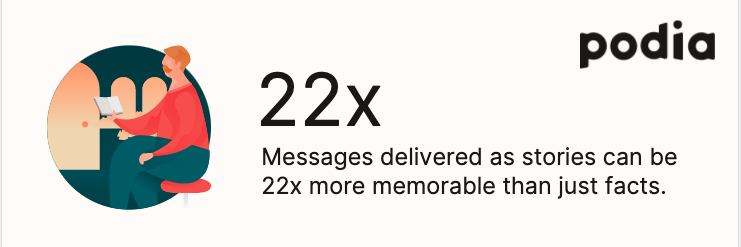
Try this email template on for size:
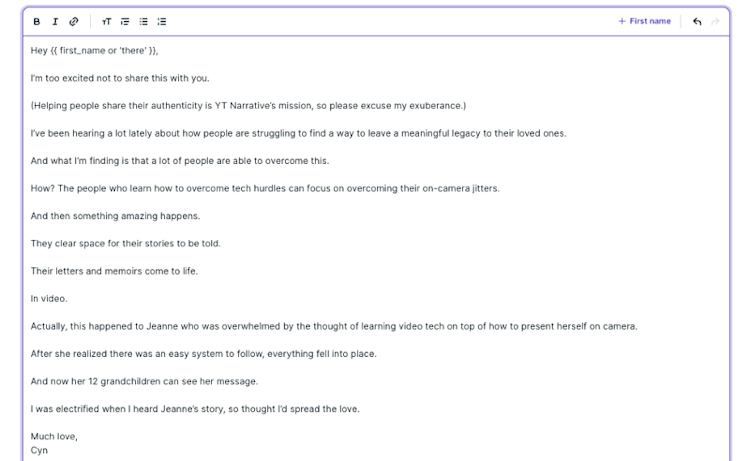
Educating your recipients about their problem is one way to move them to the next awareness stage. Asking them to admit it is another way — our next email template.
#3. The inquiry email template
Our next template sets the stage for your audience coming to their own conclusion that they have a problem, which you can do by asking them relevant questions about their life.
Even if you don’t get your audience to admit they have a problem, you’ll still leave a positive brand impression with them.
How? There’s power in being heard.
In fact, so much power that one study found when people are given a chance to share their stories and experiences with people from an opposing side, it improves their attitude about the other group.
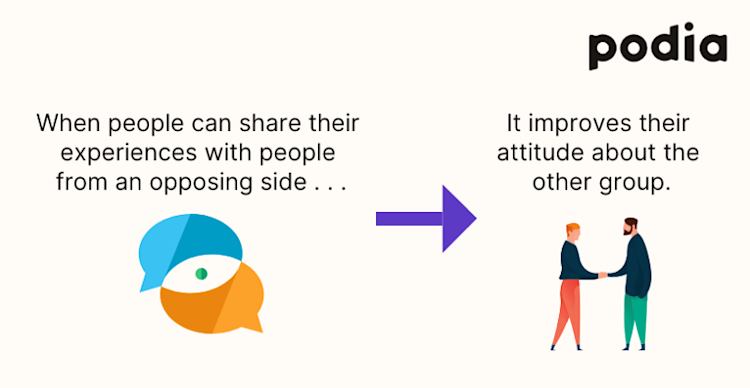
Even if the tension isn’t lightened between two sides, being heard is so appreciated.
So, the fact that you’re simply asking for your audience’s feedback and opening up a dialogue is a treat on its own.
As for the email template:
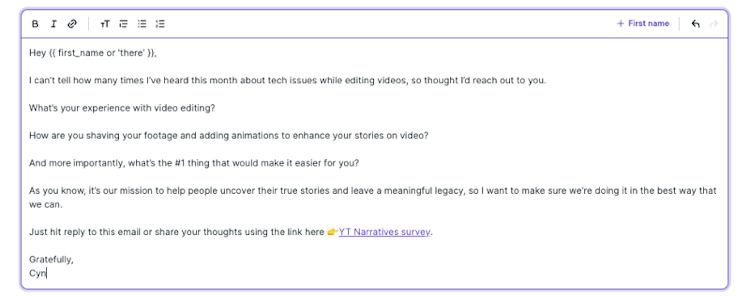
Now that you’ve nudged your audience to realize — and perhaps admit — they have a problem, they’re ready for our next series of email messaging.
Email templates for problem-aware customers
#4. The agitate problem template
The first problem-aware email template slightly agitates your audience’s problem. I say slightly because the point isn’t to torment your subscribers as much as it is to let them know you feel their pain.
And empathy is a great way to emotionally connect with your audience while presenting your brand authentically.
Believe me, as a life coach, empathy is the top way I can support any client and their situation. It goes hand-in-hand with people feeling heard, and I’ve found there’s no better way to build rapport and be real with people than to listen and show empathy.
When it comes to getting customers, a mighty 86% of consumers claim that authenticity is a key factor when deciding which brands to like and support, so it’s worth giving empathy a shot in your email messaging.
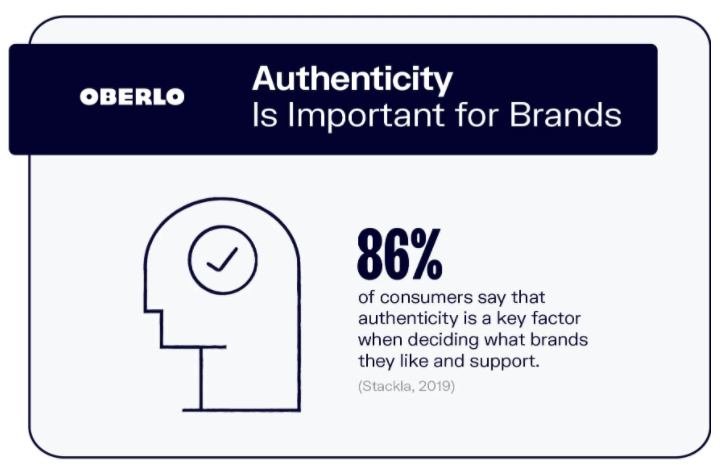
To speak to your audience’s pain points, put yourself in their shoes and think of ways to describe their problem and how they feel with as much detail as you can.
Better yet, conduct customer research to find out the exact language your target audience uses to describe their pain points. Whether it’s through social listening, online surveys, or direct conversations, look for trending phrases and words that your target audience uses.
Then, reflect that back into your email messaging.
Once you have your audience’s perspective and verbiage dialed in, consider customizing this email template:
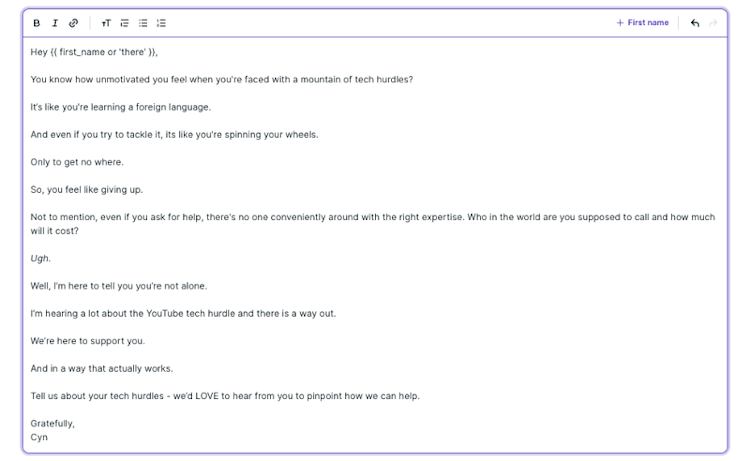
After agitating your subscribers’ pain point and sharing empathy, our next email template introduces a way for them to solve their pain point.
#5. The storytelling template
Share with your audience a compelling narrative that touches on their emotions and pain points using storytelling.
Since problem-aware subscribers aren’t yet solution-aware, you can slightly push them in that direction by educating them about solutions — not necessarily your solution, but instill confidence that there is a solution.
One way to do this is to, again, tap the power of storytelling.
It’s worth unleashing the storyteller in you, since storytelling affects your brain in several areas and ways, including:
-
Neural coupling — relating your story to their own experience
-
Mirroring — similar brain activity to storyteller
-
Dopamine — if it’s emotionally-charged it’s more memorable
-
Cortex — additional areas in your brain are engaged (motor, sensory, and frontal cortex)
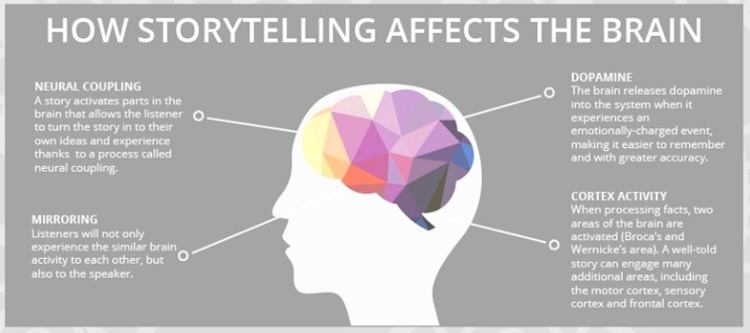
Now, for the email template:
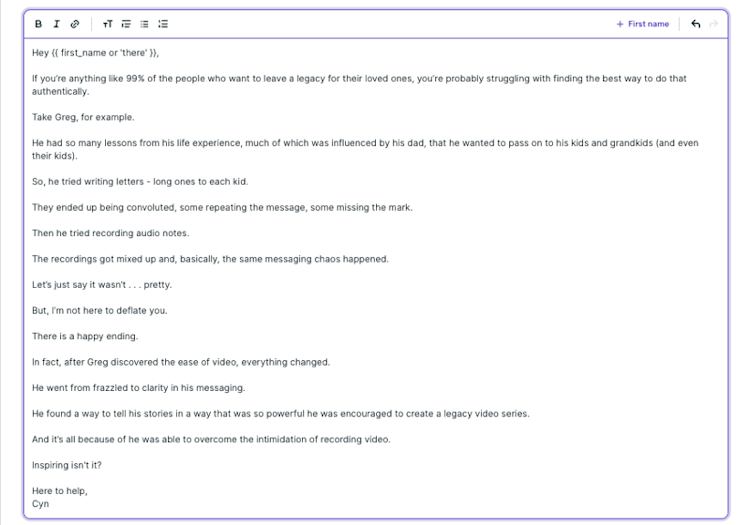
Another way to convince your subscribers that there are ways to solve their problem is to offer an arsenal of educational resources. Head to our next template for the details.
#6. The helpful resources email template
A powerful way to support your audience and move them to the next awareness level is to provide them with an abundance of helpful and educational resources.
Even if it’s not the exact solution or product you’re promoting in your email messaging — and it shouldn’t be at this stage — it’s important to supply your subscribers with helpful resources which position you as the expert in your field.
One trusty way to do that is to provide links to helpful articles published on your blog (kinda like this one!).
There’s a reason why we dedicate so much of our time supporting creators with helpful articles: a significant 71% of B2B consumers say they consume blog content during their purchasing process.
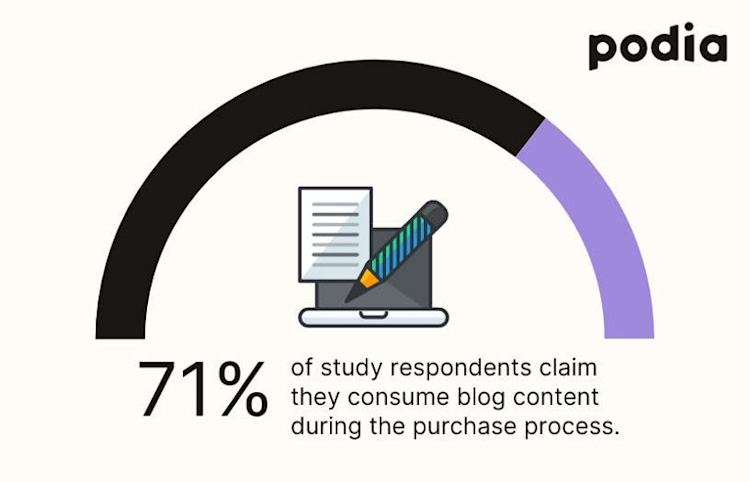
Another great option is to provide links to helpful videos as resources. Considering 81% of marketers use video as a marketing tool, which is up from 63% the year prior, I’d say it’s a content marketing format that works.
Regardless of the content marketing format you decide to take on, the point is to share a range of helpful resources that generally help your subscribers solve their problems within your topic and niche.
Here’s how it translates to an email template:

What happens after your subscribers realize there’s a solution? It’s time to guide them toward your product.
Email templates for solution-aware customers
#7. The easy fix template
At this point, your subscribers are aware that there are solutions, but they still need to learn about products and brand options.
This is a great awareness level for educating them about an easy fix — as in, a process that’s simple. One that makes them feel like they can, and should, solve their problem.
One of the best ways to motivate someone to achieve something is to simplify it. Break it down into micro-steps.
Cut out the messy clutter.
Clutter is both a physical and emotional thing. In fact, stress from clutter can lead to a slew of other issues, like poor eating choices and oversleeping.
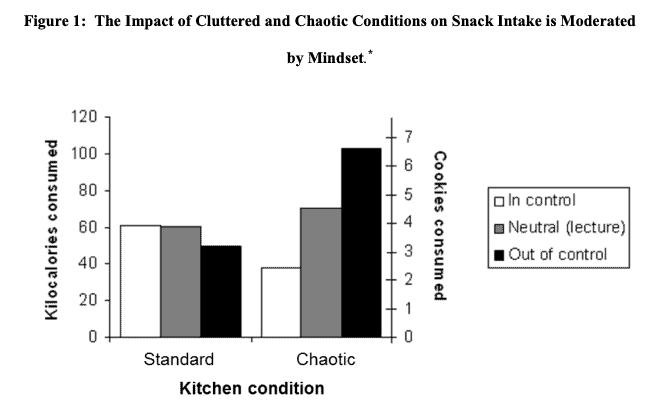
In the same way that clutter adds stress and overwhelm to your life, complicated processes will do the same to your audience.
The main takeaway here is to simplify the how for your audience. It’ll motivate them to solve their problem.
Take it a step further and add an element of suspension. Intrigue them and entice them to find out the simple secret sauce to solving their problem by clicking your CTA for the answer, instead of sharing it in the body of your email.
Check out the email template:
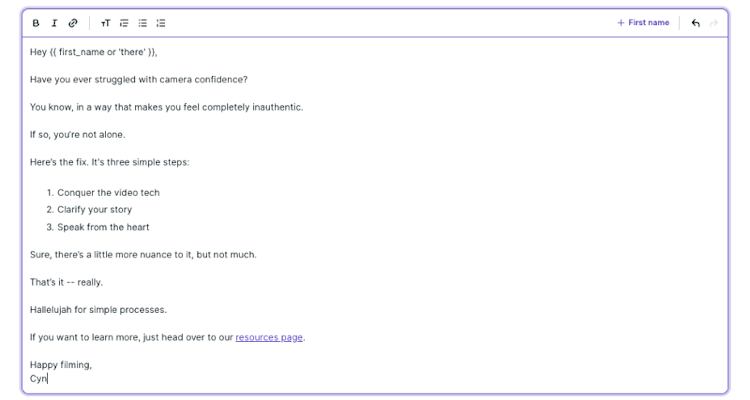
Now that your subscribers are warmed up to the idea of a solution, our next email marketing template educates them about your brand’s solution.
#8. The behind-the-scenes email template
This solution-aware email template is great for boosting your authenticity and trust among your audience.
This is something that’s super important, considering a whopping nine out of 10 consumers will stop purchasing from brands that aren’t transparent.

As you’re leading up to the messaging that your particular brand can solve your audience’s problem, this email template helps you demonstrate that your team is working hard to fulfill its mission of solving problems for people.
Whether it’s how hard your team has been working to perfect and improve a product, or the process that goes into delivering a service, showcase your brand’s expertise and commitment to delivering that expertise.
Customize our template with your brand’s behind-the-scenes content:
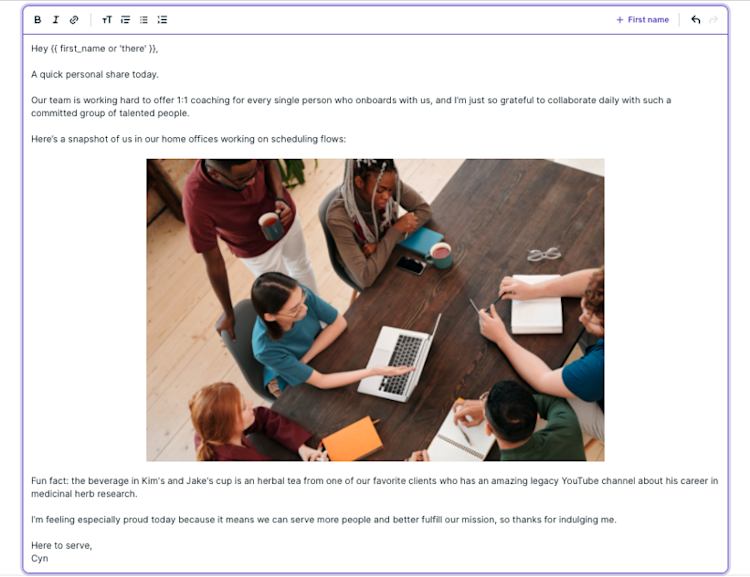
Now that your subscribers know there are products that solve their problems, it’s time to distinguish yours from the rest using our next set of email templates.
Email templates for product-aware customers
#9. The testimonial email template
Our next type of email features a case study or testimonial of a happy customer who already achieved the results your subscribers want.
Testimonials are a powerful way to convert your subscribers. So much so that if you use them regularly, you can generate about 62% more revenue any time a customer visits your brand.
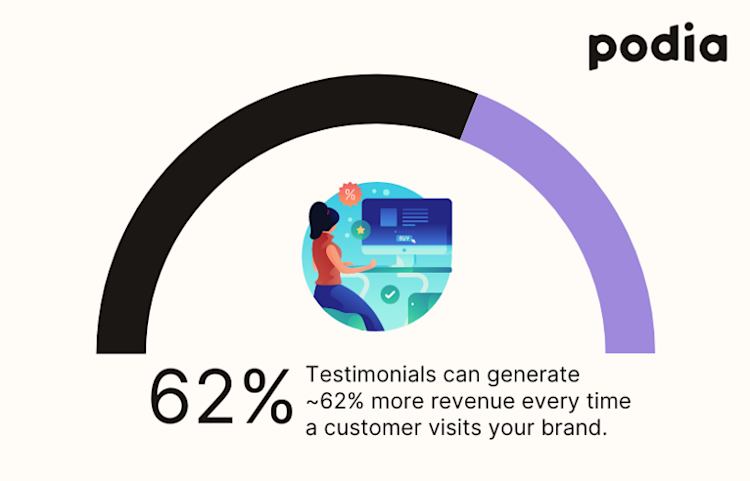
Plus, 88% of consumers claim they trust reviews as much as personal recommendations.
Doesn’t get closer to an actual referral than that, right?
Here’s an email template to use when featuring testimonials:
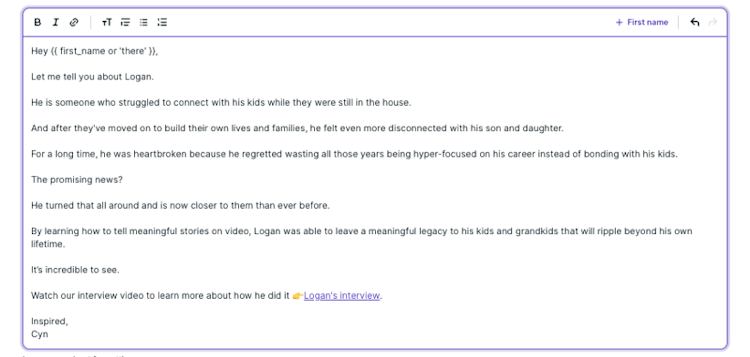
If getting testimonials or a case study doesn’t sound appealing to you, try featuring proven results in another way. Look to our final email template in this section for the details.
#10. The proof email template
This email template is also about reassuring your subscribers that your solution works. Instead of singling out one happy customer, it’s about providing more proof that your brand’s system works.
This could be a series of screenshots of social media posts from happy customers or a bulleted list of results that people achieved.
Alternatively, you can include images to back up the transformation. In this case, more is often better.
If you think iterating proof a few times is overkill, think again. 63% of consumers don’t believe a brand’s claims until they hear it 3–5 times.
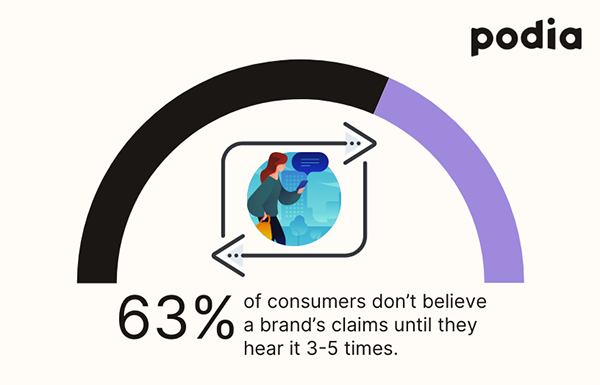
And if you want to talk peak volume, shoppers between the ages of 18–24 expect a whopping 203 reviews on average per product page.
Not that you need to feature every piece of proof under your brand’s belt, but you get the gist:
Highlight a range of proof points to show that your brand helps solve your audience’s problem. It’s a solid way to convince people your specific brand can solve their problem, too.
Here’s the email template:
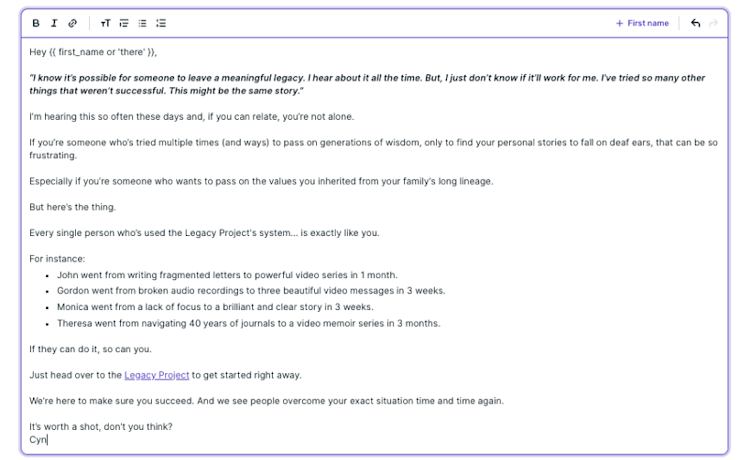
Your track record and happy customers aren’t the only way to distinguish your product. There’s also your unique benefits.
#11. The unique benefits email template
Another compelling way to spotlight your brand’s product as the solution to their problem is to highlight your product’s unique benefits.
Ask yourself:
What makes your brand stand out from other options?
To pinpoint unique benefits, it’s also helpful to think of your offerings in terms of features and benefits.
Not sure what the difference is? That’s fair, the terms are a little vague. Features are cool things that your product or service has or functions as. Benefits are the outcomes — what those cool things do for your customers.
If you’re having trouble landing some unique benefits to brag about, give this handy features vs. benefits matrix a whirl.
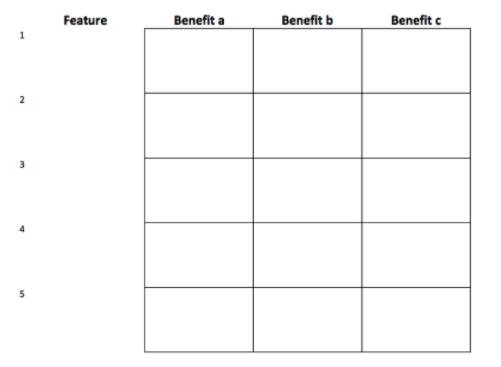
Once you have a clear set of unique benefits to showcase, present them proudly using our email template:
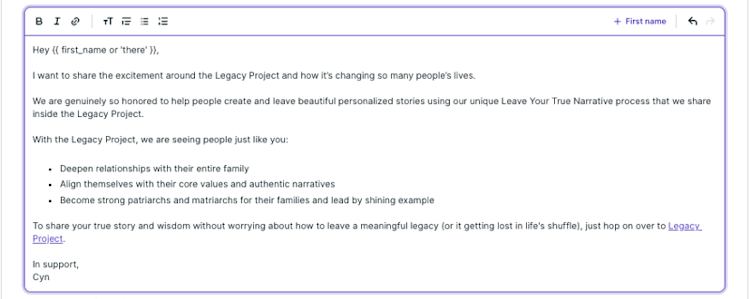
Now, let’s head into messaging for the final awareness level — for those who are most aware.
Email templates for most aware customers
#12. The sense of urgency email template
At this stage of the awareness funnel, your audience just needs one more nudge to win them over and select your solution.
To help convince them to act now, try creating a sense of urgency in your email messaging.
This could be offering special pricing for a limited time, like in this Barnes & Noble email special.
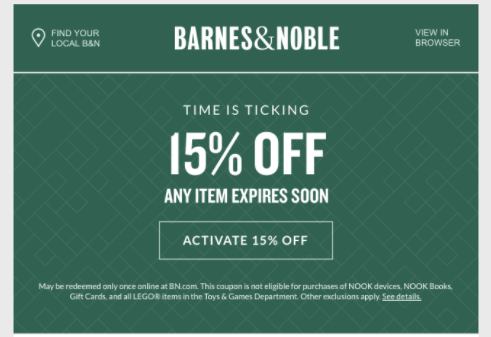
Or it could mean relying on scarcity, where your inventory will run out if they don’t purchase.
No matter how you create a sense of urgency in your email messaging, if you do it right, it can boost your sales. Just like it did for Marcus Taylor, founder of Venture Harbour, who increased sales by 332% using this psychology.
Impressive, right?
In template form, your sense of urgency email might look something like:

After nudging your subscribers to take action, our next email template helps seal the deal.
#13. The FOMO email template
This template is another angle based on classic marketing psychology. Create a fear of missing out (FOMO), or at least agitate their sense of FOMO, in your email messaging.
There’s a reason why marketers use this psychology so frequently: it converts.
60% of people make purchases because of FOMO, and they do it mostly within 24 hours.
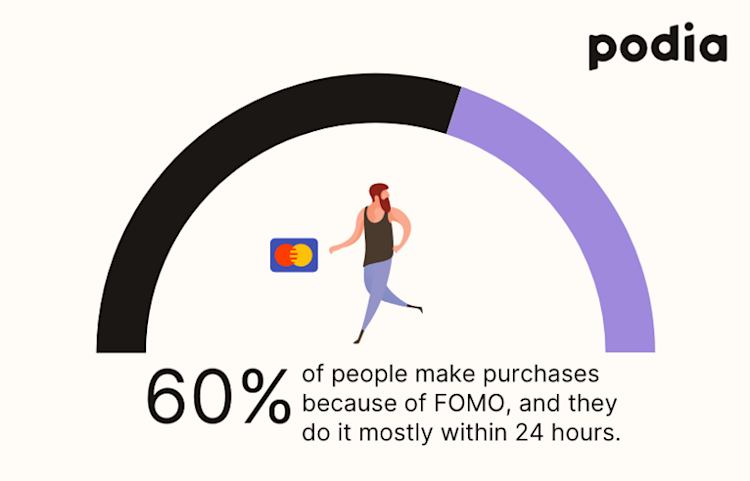
What’s more, 36% of people are afraid of feeling like an outsider.
Here’s one way to (ethically) use FOMO in your email messaging:
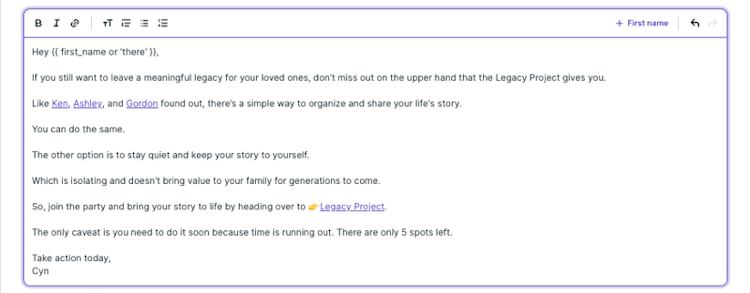
If FOMO and a sense of urgency don’t convert your email subscribers, our honesty email template might do the trick.
#14. The “let’s be honest” email template
Our final email template today rides on a bit of tough love, where you challenge your prospective customers to be real with themselves and finally confront their problem with a real solution.
It’s a way for you to be real, too, and to encourage them to take action and solve their problem.
Afraid to be too real with your audience? Don’t be.
There’s promising news when it comes to honesty and advertising. 72% of consumers feel that the ads they see, read, or hear are honest, which is much better than the last log of only 56% three years prior.
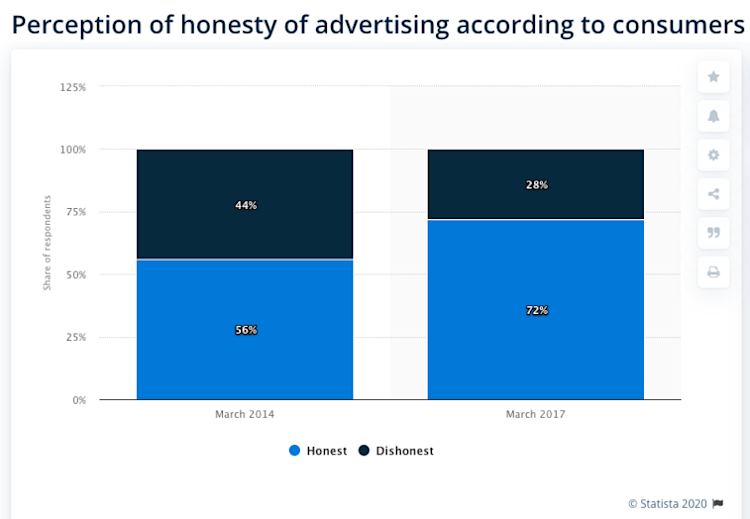
This is great because people expect honesty. They want you to be transparent in your brand.
In fact, 86% of Americans say that business transparency is more important than ever before.
All this to say, this final email template today helps you fill that consumer craving by being honest and transparent about how your product can help them.
To be transparent, be sure to tap into the four dominant definitions of transparency, which are:
-
Openness
-
Clarity
-
Honesty
-
Authenticity
Here’s our final email template today:
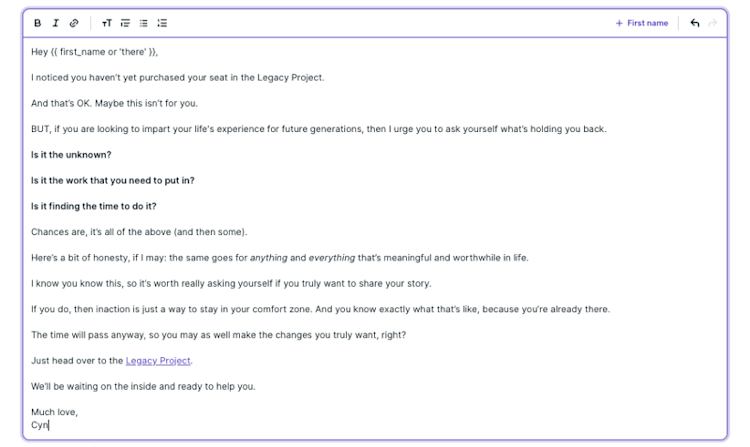
Match your email messaging to your audience’s awareness stage
While crafting a sequence of emails that tailors to your subscribers’ every awareness stage is a heavy lift, it’s one that can pay off numerous times in dividends.
Here’s the lowdown for email template themes according to awareness level:
-
Completely unaware — This stage is suited for emails that introduce your brand, your audience’s problem, or make an inquiry about the problem.
-
Problem-aware — Consider emails that agitate the problem, tell a story, and share helpful resources.
-
Solution-aware — Try out emails that show an easy fix and a sneak peek behind the scenes.
-
Product-aware — Write emails that feature a testimonial, illustrate proof, and highlight unique benefits.
-
Most aware — Create a sense of urgency, leverage FOMO, and be honest in your email messaging.
May your every email resonate — and may these templates help you get there.
And if you’re looking for a tool to run your entire online business — email marketing included — sign up for your free 30-day trial with Podia today.
